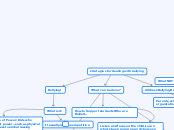strategies for dealing with bullying
Bullying!
What is it:
It usually involves repetition
An Imbalance of Power: Kids who bully use their power—such as physical strength, access to embarrassing information, or popularity—to control or harm others. Power imbalances can change over time and in different situations, even if they involve the same people
What can be done?
How to Support students Who are Bullied...
Listen and focus on the child. Learn what’s been going on and show you want to help.
Assure the child that bullying is not their fault.
Know that kids who are bullied may struggle with talking about it. Consider referring them to a school counselor, psychologist, or other mental health service.
Give advice about what to do. This may involve role-playing and thinking through how the child might react if the bullying occurs again.
Work together to resolve the situation and protect the bullied child. The child, parents, and school or organization may all have valuable input.
Involve the kid who bullied in making amends or repairing the situation.
The goal is to help them see how their actions affect others.
Give options to rectify the situation:
Write a letter apologizing to the student who was bullied.
Do a good deed for the person who was bullied or for others in your community.
Clean up, repair, or pay for any property they damaged.
Make it part of learning to treat others with respect:
learning or building empathy can help prevent future bullying.
Lead a class discussion about how to be a good friend.
Write a story about the effects of bullying or benefits of teamwork.
Do a project about a human rights issue going on around the world relate it to treatment of others
DO a web quest with students - present a mini issue or case study and give them a guided web quest on where to find the help for the given situation.
Address Bullying Behavior
Parents, school staff, and organizations all have a role to play.
Make sure the student knows what the problem behavior is. Young people who bully must learn their behavior is wrong and harms others.
Show students that bullying is taken seriously and calmly tell the child that bullying will not be tolerated.
Model respectful behavior when addressing the problem.
Work with the child to understand some of the reasons he or she bullied.
Follow-up. Always
